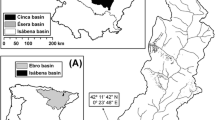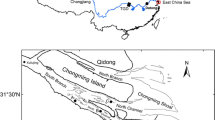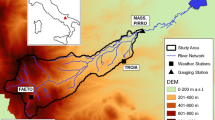Abstract
Purpose
The aim of this work was to improve the understanding of the spatial and temporal dynamics of suspended sediment transport during flushing flows in a large regulated river, the lower River Ebro (NE Spain).
Materials and methods
Relationships between sediment and discharge (i.e. discharge (Q)–suspended sediment concentrations (SSC)) were examined during six flushing flows using continuous discharge and turbidity records obtained at six monitoring sections distributed along the lower Ebro River for the 2008–2011 period.
Results and discussion
Analyses revealed marked spatial and temporal patterns. At the spatial scale, the Q–SSC relationships were mostly influenced by the different routing velocity of discharge and sediment waves. At the upstream sections, the sediment peak usually preceded peak discharge (i.e. clockwise loop); however, flow routing through the 85-km channel length tends to increase the lag between them, modifying the hysteresis towards counter-clockwise patterns in the downstream direction. At the temporal scale, the season when the artificial releases were performed strongly influenced the sediment availability, with similar-magnitude flushing flows generating higher sediment peaks in autumn than in spring.
Conclusions
These results are of great interest in order to reinforce the flushing flows programme in the lower Ebro River, so as to help achieve the sustainability of the riverine and deltaic ecosystems.




Similar content being viewed by others
References
Alexandrov Y, Laronne JB, Reid I (2003) Suspended sediment concentration and its variation with water discharge in a dryland ephemeral channel, northern Negev, Israel. J Arid Environ 53:73–84
Asselman NEM (1999) Suspended sediment dynamics in a large drainage basin: the River Rhine. Hydrol Process 13:1437–1450
Bača P (2008) Hysteresis effect in suspended sediment concentration in the Rybárik basin, Slovakia. Hydrol Sci J 53:224–235
Batalla RJ, Vericat D (2009) Hydrological and sediment transport dynamics of flushing flows: implications for river management in large Mediterranean rivers. River Res Applic 25:297–314
Batalla RJ, Kondolf GM, Gomez CM (2004) Reservoir-induced hydrological changes in the Ebro River basin, NE Spain. J Hydrol 290:117–136
Bull LJ (1997) Magnitude and variation in the contribution of bank erosion to the suspended sediment load of the River Severn, UK. Earth Surf Process Landforms 22:1109–1123
Einstein HA (1943) Discussion on distribution graphs of suspended-matter concentration. Amer Soc Civil Engineer Trans 69:957–958
Estrany J, Garcia C, Batalla RJ (2009) Suspended sediment transport in a small Mediterranean agricultural catchment. Earth Surf Process Landforms 940:929–940
Gilvear DJ (1988) Suspended solids transport in the regulated River Blithe, Staffordshire, UK. Regul River 2:117–129
Gilvear DJ, Petts GE (1985) Turbidity and suspended solids variations downstream of a regulating reservoir. Earth Surf Process Landforms 10:363–373
Heidel (1956) The progressive lag of sediment concentration with flood waves. Amer Geophysl Union Trans 37:56–66
Hicks DM, Goring D (2009) Modifying flushing flows in the Mohawango River to mitigate downstream effects. NIWA Client Report CHC2009-164, November 2009. Christchurch, New Zealand
Hudson PF (2003) Event sequence and sediment exhaustion in the lower Panuco Basin, Mexico. Catena 52:57–76
Kondolf G (1997) Hungry water: effects of dams and gravel mining on river channels. Environ Manag 21:533–551
Konhauser KO, Powell MA, Fyfe WS, Longstaffe FJ, Tripathy S (1997) Trace element chemistry of major rivers in Orissa State, India. Environ Geol 29:132–141
Lawler DM, Petts GE, Foster IDL, Harper S (2006) Turbidity dynamics during spring storm events in an urban headwater river system: the Upper Tame, West Midlands, UK. Sci Total Environ 360:109–126
Leopold LP, Wolman MG, Miller JP (1964) Fluvial processes in geomorphology. WH Freeman, San Francisco, 522 p
Lewis AD (1921) Silt observations of the River Tigris. Inst Civil Eng Min Proc 212:393–399
López-Tarazón JA, Batalla RJ, Vericat D, Balasch JC (2010) Rainfall, runoff and sediment transport relations in a mesoscale mountainous catchment: the River Isábena (Ebro basin). Catena 82:23–34
Marcus WA (1989) Lag-time routing of suspended sediment concentrations during unsteady flow. Bull Geol Soc Amer 101:644–651
Mossa J (1988) Discharge–sediment dynamics of the lower Mississippi River. Trans Gulf Coast Assoc Geol Soc 38:303–314
Nadal-Romero E, Latron J, Martí-Bono C, Regüés D (2008) Temporal distribution of suspended sediment transport in a humid Mediterranean badland area: the Araguás catchment, Central Pyrenees. Geomorphol 97:601–616
Novoa M (1984) Precipitaciones y avenidas extraordinarias en Catalunya. Proceedings of Jornadas de Trabajo sobre Inestabilidad de laderas en el Pirineo, Barcelona, pp 1–15. E.T.S., Ingenieros de Canales Caminos y Puertos, Barcelona
Oeurng C, Sauvage S, Sánchez-Pérez J-M (2010) Dynamics of suspended sediment transport and yield in a large agricultural catchment, southwest France. Earth Surf Process Landforms 35:1289–1301
Petts GE, Foulger TR, Gilvear DJ, Pratts JD, Thomas MC (1985) Wave-movement and water-quality variations during a controlled release from Kielder Reservoir, North Tyne River, U.K. J Hydrol 80:371–389
Prats J, Armengol J, Marcé R, Sanche–Juny M, Dolz J (2011) Dams and reservoirs in the lower Ebro River and its effects on the river thermal cycle. In: Barceló D, Petrovich M (eds) The Handbook of Environmental Chemistry, vol 13. The Ebro River Basin. Springer, Berlin, pp 77–95
Sabater S, Muñoz I, Artigas J, Romaní AM, Pérez M, Duran C (2011) Aquatic and riparian biodiversity in the Ebro watershed: prospects and threats. In: Barceló D, Petrovich M (eds) The Handbook of Environmental Chemistry, vol 13. The Ebro River Basin. Springer, Berlin, pp 77–95
Shaw EM (1983) Hydrology in practice. Van Nostrand Reinhold, London, 539 p
Smith HG, Dragovich D (2008) Improving precision in sediment source and erosion process distinction in an upland catchment, south-eastern Australia. Catena 72:191–203
Steiger J, Gurnell AM, Petts GE (2001) Sediment deposition along the channel margins of a reach of the middle River Severn, UK. Regul River 17:443–460
Tena A, Batalla RJ (2013) The sediment budget of a large river regulated by dams (The lower River Ebro, NE Spain). J Soils Sediments 13:966–980
Tena A, Batalla RJ, Vericat D, Lopez–Tarazón JA (2011) Suspended sediment dynamics in a large regulated river over a 10-year period (the lower Ebro, NE Iberian Peninsula). Geomorphol 125:73–84
Tena A, Batalla RJ, Vericat D (2012) Reach-scale suspended sediment balance downstream from dams in a large Mediterranean river. Hydrol Sci J 57:1–19
Tena A, Książek L, Batalla RJ, Vericat D (2013) Assessing the geomorphic effects of a flushing flow in a large regulated river. River Res Applic 29:876–890
Vericat D, Batalla RJ (2005) Sediment transport in a highly regulated fluvial system during two consecutive floods (lower Ebro River, NE Spain). Earth Surf Process Landforms 30:255–272
Vericat D, Batalla RJ (2006) Sediment transport in a large impounded river: the lower Ebro River, NE Iberian Peninsula. Geomorphol 79:72–92
Vericat D, Batalla RJ, Garcia C (2006) Breakup and reestablishment of the armour layer in a large gravel-bed river below dams: the lower Ebro. Geomorphol 76:122–136
Walling DE, Webb BW (1983) Patterns of sediment yield. In: Gregory KJ (ed) Background to palaeohydrology. Wiley, Chichester, pp 69–100
Walling DE, Webb BW (1987) Suspended load in gravel-bed rivers: UK experience. In: Thorne CR, Bathurst JC, Hey RD (eds) Sediment transport in gravel-bed rivers. Wiley, Chichester, pp 691–723
Williams GP (1989) Sediment concentration versus water discharge during single hydrologic events in rivers. J Hydrol 111:89–106
Acknowledgments
This research has been carried out within the framework of a series of research projects funded by the Spanish Ministry of Education and Science 2002–2012 (REN2001-0840-C02-01/HID, CGL2005-06989-C02-02/HID, CGL2006-11679-C02-01/HID, CGL2009-09770/BTE); the Spanish Ministry of Economy and Competitiveness, through the project Consolider Ingenio 2010 CSD2009-00065; and by research contracts to (a) study the polluted sediments in the Flix Reservoir 2006–2008, funded by the Spanish Ministry of Environment and the Catalan Water Agency; (b) characterise riverbed conditions under macrophyte cover in the lower Ebro (2009–2011), funded by Ebro Water Authorities—CHE, through URS-España; and (c) to study hydraulic and sedimentary characteristics of selected flushing flows, funded by ENDESA Generación SA. The second author has a Ramon y Cajal Fellowship (RYC-2010-06264) funded by the Spanish Ministry of Science and Innovation. Special thanks are due to the Ebro Water Authorities and Endesa Generación SA for their collaborative support during the investigation, providing assistance, and useful data. The support of the members of the Fluvial Dynamics Research Group (RIUS) is greatly appreciated. We are grateful to Mark Smith for reviewing the first version of this manuscript and to Josep Carles Balasch for providing insights into the river–groundwater exchange processes that help us to assess the validity of the Q routing procedure.
Author information
Authors and Affiliations
Corresponding author
Additional information
Responsible Editor: Axel Bronstert
Electronic supplementary material
Below is the link to the electronic supplementary material.
ESM 1
(PDF 827 kb)
Rights and permissions
About this article
Cite this article
Tena, A., Vericat, D. & Batalla, R.J. Suspended sediment dynamics during flushing flows in a large impounded river (the lower River Ebro). J Soils Sediments 14, 2057–2069 (2014). https://doi.org/10.1007/s11368-014-0987-0
Received:
Accepted:
Published:
Issue Date:
DOI: https://doi.org/10.1007/s11368-014-0987-0




